#identification guide
Explore tagged Tumblr posts
Text
classic Atoll tour poster (2021), sent in by fan
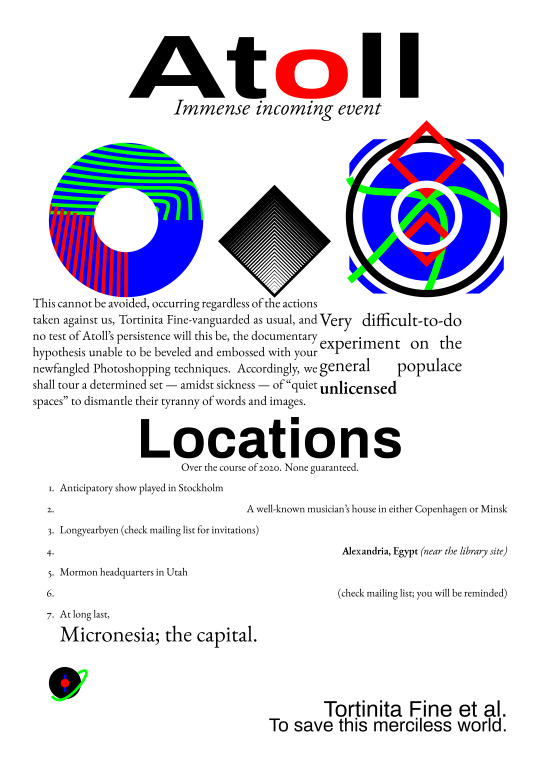
2 notes
·
View notes
Text
US Native Scorpion ID
So this is a project I’ve wanted to do for a while but was extremely daunted by. the task. Identifying US native scorpions is hard, a lot of literature on the subject is out of date and there are precious few knowledgeable people that are working on the subject. To make matters harder for me, I wanted to aim this guide at the layman naturalist, someone who was going to look at surface level identification features but not know or care what trichobothria patterns were. As such, I’d like to write a disclaimer and say this guide is for entertainment purposes only. I have excluded many, many species from it and chose to only focus on scorpions I thought were common, readily identifiable, or interesting. I also excluded subspecies, and intentionally picked examples for the pictures I thought were the most obvious or distinct. Some scorpions in the US are medically significant, and anyone can have an allergic reaction to a sting, so caution must be taken when identifying. I also took most of these pictures off inaturalist or bugguide, but I will supply some of my own pictures here when applicable. Family organization is based on the classification currently up on TheScorpionFiles, but taxonomy is subject to change so that's another disclaimer.
Without further ado, let’s talk about scorpions.
The US is a treasure trove of scorpion activity. We are home to 7 unique families of scorpions, some of which are only found in the US and Mexico. The southwestern United States is one of the most diverse and populated scorpion hot spots in the world. Despite this variety, most people don’t pay much attention to the scorpions they live alongside. Aside from a few standout examples (Arizona Bark Scorpion, Desert Hairy Scorpion) US native scorpions are almost entirely unknown. I wanted to make this guide to introduce people who didn’t know much about scorpions to some of the diversity the US has to offer, as well as be a basic primer to scorpion identification and morphology.
So first things first, some basic scorpion biology.


Some important things to note in this diagram is the chela refers to the wide part of the pincers not including either the fixed or movable finger. The hand refers to the chela plus the fixed finger, with the movable finger connecting to the hand. Similarly, the aculeus refers to just the stinger, and the vesicle refers to just the venom bulb before the stinger. The telson refers to the aculeus plus the vesicle. The telson sometimes includes a subaculeur tooth, which looks like a second, smaller stinger on the vesicle. This can be an important diagnostic feature. I will informally refer to a scorpion's “claw”, “body”, and “tail” to make things easier. Another important diagnostic feature is the presence of granulation, which are distinct bumps on a scorpion carapace that makes it look granular or rough. Sometimes the granulation can be in a distinct line, which is called a carinae. There are smooth carinae too, which are just raised distinct lines without granulation, but I won’t be talking about those in this guide. This guide is primarily going to focus on features you can easily see without flipping a scorpion over or using a microscope, so although I highly recommend you look into scorpion biology I won’t go into too much here.
The Scorpions
Anuroctonidae
Two large “humps” on the prosoma
Noticeably darker fingers
Swollen stinger, more prominent in males
Median eyes close together and on a raised darkened hump, almost giving the appearance of having one median eye
Buthidae
Thin claws
Long, thin tail (markedly longer in males)
Front of prosoma has a slight “v” shape
Chactidae
Distinct “v” in front edge of the prosoma
Diplocentridae
Distinct subaculear tooth
Distinctly shiny
Little to no granulation
Distinct “v” shape in front edge of prosoma
Hadruridae
Hairy tail
Large
Front of prosoma curved outwards
Superstitioniidae
Vaejovidae
Front edge of prosoma mostly straight with only slight notching
One of the most diverse family of scorpions, highly variable in appearance
References
Francke, O. F. 1975 . A new species of Diplocentrus from New Mexico and Arizona (Scorpionida ,
Diplocentridae) . J. Arachnol. 2 :107-118 .
Haradon, R. M. 1983 . Smeringurus, a new subgenus of Paruroctonus Werner (Scropiones, Vaejovidae).
J. Arachnol., 11 :251-270.
Soleglad, Michael & Fet, Victor. (2004). The systematics of the scorpion subfamily Uroctoninae (Scorpiones: Chactidae).. Revista Ibérica de Aracnología. 10.
Stockmann, R., & Ythier, E. (2010). Scorpions of the World. N.A.P. Editions.
Stahnke, H. L . 1974 . Revision and keys to the higher categories of Vejovidae (Scorpionida). J .
Arachnol. 1 :107-141 .
Stockwell, S. A. and J. A. Nilsson. 1987. A new species of Diplocentrus Peters from Texas
(Scorpiones, Diplocentridae). J. Arachnol., 15:151-156.
Williams, S. C. (1980). Scorpions of Baja California, Mexico, and Adjacent Islands. OCCASIONAL PAPERS OF THE CALIFORNIA ACADEMY OF SCIENCES.
Photos used were primarily taken off of inaturalist, though some of them are my own.
Here's the Google Doc where everything's together as well.
#invertebrates#invertiblr#inverts#invert#bugblr#scorpion#entomology#identification#scorpion identification#identification guide
6 notes
·
View notes
Text
Dirt Daily. A Flat Fender Jeep history lesson and Identification guide - Fred Williams
Everyone loves the early Willys Flatfender Jeeps, but not everyone knows their history or the different models. I’ve been a Jeep fan for a long time so I thought I’d tell you everything I know about flatfenders, which isn’t everything, but it is a lot. These are the early Jeeps that started during World War 2 and became a national treasure and the sparked the start of the off-roading past time.…
youtube
View On WordPress
#Dirt Daily#Dirt Everyday#Flat Fender Jeep#Fred Williams#Identification Guide#Jeep History#Willys Jeep#YouTube
1 note
·
View note
Text
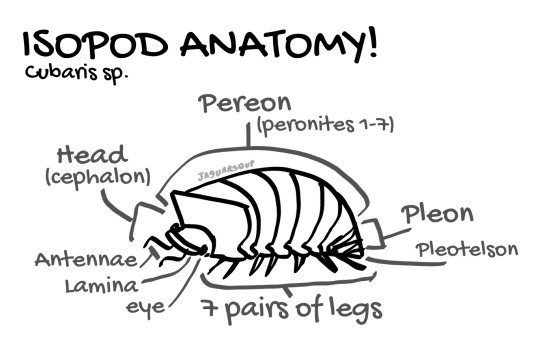
Dichotomous key is nowhere near functional yet so here’s a little anatomy diagram I made.
#real isopod hours#isopods#not an identification#isopod differentiation guide#the (iso)podcast#Cubaris sp#art#bug art#diagram#do not feed to ai#do not use for machine learning
172 notes
·
View notes
Text

Vampire Identification Guide
The Vourdalak is French film is based on a Russia novella that predates Bram Stoker’s Dracula by 58 years. It tells the tell of a family waiting for Gorcha (their patriarch) to return from fighting the Turks. Before leaving he warned them, if he returned after 6 day - do not let him enter the house. But he returns on the 7th day!
Vourdalaks are from Balkan and Slavic folklore - vampires that return from the grave to feed on their family, decimating their bloodline and feasting on the blood of all those they hold dear.
A unique element of this French film is the Gorcha is depicted as a life size puppet, voiced by the director Adrien Beau.

#vampire#nosferatu#the vourdalak#folklore#French film#life size puppet#Gorcha#bram stoker#Vampire Identification Guide
181 notes
·
View notes
Text
having trouble finding the difference between the larry and rob species?
if it has a good posture and straight legs, it's a larry!

if it looks like a bunch of snakes pretending to be a larry, it's a rob!

hope this helped!
#this is a wildlife identification guide#mimicry is common in nature#dr wrecker#rob tawog#tawog rob#rob wrecker#larry needlemeyer#larry tawog#tawog larry#tawog#the amazing world of gumball
106 notes
·
View notes
Text

I have THE biggest, BEST news EVER--
I GOT A BOOK CONTRACT!!!!!!!!
I am exceptionally pleased to announce that I have just signed a contract with Ten Speed Press (a division of Penguin Random House) to publish...
The Everyday Naturalist: How to Identify Animals, Plants, and Fungi Wherever You Go!
It is slated for publication in early Summer 2025, and will be written for anyone who wants to be able to identify the living beings around them regardless of educational level or experience. A HUGE thank you to my literary agent Jane Dystel of Dystel, Goderich & Bourret LLC, and my editor at Ten Speed Press, Julie Bennett!
This isn't just another field guide--it's a how-to book on nature identification that helps you go from "I have no idea what this animal/plant/fungus is and I don't know where to start" to "Aha! I know how to figure out what species I'm looking at/hearing!" Those familiar with my nature ID classes know that I emphasize skills and tools accessible to everyday people. Whether you're birdwatching, foraging, or just enjoying the nature around you, my goal is to help you be more confident in figuring out what living beings you encounter wherever you go--and not just in the Pacific Northwest.
The Everyday Naturalist will not only explain what traits you need to pay attention to like color, size, shape, location, etc. and how to use them to differentiate among similar species, but will also detail how and when to use tools like apps, field guides, and more. (And given the current kerfuffle about A I generated foraging books, I will of course include information on how to determine the veracity of a given book or other resource.) And my editor and I have already been discussing some great additions to the book that will make it even more user-friendly!
Are you excited about this? I certainly am! I wanted to wait until the pixels were dry on the contract before going public with this (though my newsletter subscribers got to hear about it last month, lucky them!) It still doesn't feel real, but I'm already working on the manuscript so it'll sink in soon enough.
I will, of course, keep you all apprised of my progress because this project is going to be a big part of my life over the next several months as I write and edit and write and edit and wash, rinse, repeat. So keep your eyes on this space for updates (and feel free to add yourself to my monthly email newsletter here, too!)
#nature#nature identification#animals#plants#fungi#field guide#mushrooms#foraging#birding#birdwatching#scicomm#science communication#books#nonfiction books#publishing#wildlife#science#biology#botany#mycology
989 notes
·
View notes
Text
A Look In My Book!
On The Twelfth Day of Fun I present... a look inside my book! Thank you for making The Guide To Kimono such a success! For those of you who have bought a copy already, thank you so much! For those of you who are on the fence or just want to know more before you buy, then this is for you! First, let's look at some pages that relate to the karyukai, specifically, that of hikizuri/susohiki:


Next, let's look at darari obi:

For those of you who continuously ask about how to date and price your kimono, this book is full of information to do just that and examples to give you ideas of what's worth what. Here's a snippet on what can raise or lower the price of your kimono:

Prior to this page is an index of over 150 common, uncommon, and rare kimono motifs in English, romaji, and kanji (with visual examples to boot!). Another example of a page that shows how to date is as follows:

You may have noticed that the estimated price on the kimono shown on the page above has changed since I featured it a few days ago. This is due to some newer kimono coming onto market in the past year that have sold for similar prices that were higher than the published price, but that price on the page would still be considered a fair price if trying to sell (which are what the prices in the book are). So, if any of this has interested you then you can pick up a copy at any of the links below: Amazon America (currently on sale!) Barnes & Noble USA Amazon Canada Indigo Canada Amazon UK (also on sale!) Waterstones UK Schiffer Publishing Worldwide (Small Edit: So apparently the links are working on and off and may be having an issue on Tumblr's end right now [I double checked the URLs and they are correct], so if they're not working then just go to the websites themselves and type "The Guide To Kimono" into the search bar. Thanks!)

50 notes
·
View notes
Text
love the concept of the 8 other realms being very well-known throughout the wider galaxies but Asgard is considered obscure knowledge that even if someone has heard Asgard then the name is all they know
#Thor trying to prove his identity and it is NOT going well#what do you mean 'ID' what kind of identification is needed? something unique? well this is my hammer... very confirmatory isnt it?#''it was made by the dwarves of nidavellir as per legend and is well known for all the feats i have accomplished with it!''#''yes yes we all know nidavellir but this is not an ID card''#everyone knows terra as per the gotg movies like that's just common knowledge apparently alongside like. the kree and skrulls knowing#loki mentions jotunheim and the guy perks up like oh you mean the cool ice giants?? .......you aren't that. you are not fooling anyone.#'we have a species guide and yes jotun are here with a picture too. we do not have any image under asgard so you need proof'#'we dont CARRY PROOF WITH US. No one on Asgard does that!'#they just get the most diabolical side-eyes#they are going to get arrested#''did you hear of malekith? we fought on svartalfheim recently and i saved that universe from darkness!''#*eyebrow raise* ''malekith the rebel dark elf commander from a millennia ago?''#''yes! that's the one!!''#''derek can you get the nova corp commander to hurry up they are clearly liars''
24 notes
·
View notes
Text
I think my number one art tip that isn't actually drawing related is that you have to curate a bunch of reference/inspiration resources and it can't just be pinterest or google images. You need your own stuff.
Option one: Photo books. Get them from the library and copy or photograph your favorite pages. Even better, you can buy these at thrift stores or library sales for cheap. Or you can pirate legally download them, which is less recommended because half the appeal of these things is flipping thru them and they look great on a shelf. The good ones are gonna be glossy and huge.


(first six I grabbed to photograph: cambridge glass, stained glass, and oriental rugs are great to grab ideas for patterns/color palettes; weathervane has great stylized animal designs; movies is for people, poses, and clothes; bilder is mainly people and cityscapes)
Option two: Non-google, non-pinterest websites. There are two paths here: big galleries like DPLA/Europeana/Wikimedia Commons/etc or specific topic websites (I get a lot of use out of UniformFreak, Featherbase, and Skull Index). Bookmark them when you find them bc who knows if you'll be able to find them again. The advantage of the first is a lot of options, the advantage of the second is they can get real specific.

(theoldrobots.com, incredible collection of robot pictures)
The main advantage of these is you're gonna be getting unique reference materials. A lot of times, photos in print books aren't gonna be available online because the photos are taken specifically for the book. This especially applies to older books which may not have an ebook version or have been scanned.
Basically, the idea is that the more wells you're drawing from, the better your stuff is gonna be. Google images, etc., is great if you need to quickly check something like where the leg bends on a horse or find a mechanical shape to trace for a sketch. If you're browsing it for ideas... use something better.
#my beef with pinterest is a separate thing but basically you cannot be thinking#'oh i'd like to draw a scary castle! lets see whats on pinterest for scary castle' NO!!!!!#all my book examples here are art books but wildlife identification guides are also highly recommended for animal drawing
24 notes
·
View notes
Text






Some dragons of silicon:
Silicon Moissanite Opal Quartz Aventurine Agate
I'll finish this chapter, I swear! There are only 12 (13) dragons of different types of quartz left (hilfe)
83 notes
·
View notes
Text
Vaejovidae
Paruroctonus boreus
Dark body
Prosoma in front of median eyes is lighter than rest of prosoma
Back edge of tergites lighter than front edge, giving lined appearance
Chela bulky with strong carinae
Most Northern occuring scorpion, only scorpion like it from Oregon north. Also occurs in higher elevations than most other scorpions
Wide range, found from Washington and Montana south to Arizona, Colorado, and California
Paruroctonus silvestrii
Prosoma and body have silver mottled coloring
Chela bulky with strong carinae
Found throughout California
Paruroctonus becki
Distinguished from Paravaejovis by the lack of terminal denticle on the dorsolateral carinae of the tail
Can sometimes have a dusky semicircle going from median eyes to lateral eyes, similar to in Hadrurus arizonensis
Chela narrow with some visible carinae
Color highly variable
Serradigitus gertschi
Brown in coloration with variable levels of mottling
Fingers have distinctly “hooked” tips
Found throughout California
Smeringurus mesaensis
Long legs and tail
Body and prosoma with little to no granulation
Pale yellow in color
Fingers the same color as chela
Distinct long hairs on tibia and basitarsus
Some color varieties have an orange-peachy tint to pedipalps and tail
Found in the southwest from southern California to Nevada and Arizona
Smeringurus vachoni
Chela blocky and has darker lines
Fingers darker than chela
Prosoma and body uniformly dark, area between median eyes and front of prosoma almost entirely dark
Males have distinct tooth on movable finger
Found in the southwest from southern California to Nevada and Arizona
Smeringurus aridus
Lighter in color, only dark area if present is around median eyes
Fingers darker than chela
Found in Southern California
Paravaejovis confusus
Uniformly brown with no mottling
Fingers not distinctly longer than chela
Found in the southwest from Arizona, California, Nevada, Utah and southern Oregon and Idaho
Paravaejovis puritanus
Uniformly brown with no mottling
I think they look shinier than the other Paravaejovis, but this is not a diagnostic characteristic
Can have dusky tints around the joints of the legs
Found in southern California
Relatively large, one of the largest Paravaejovis
Chela narrow
Paravaejovis waeringi
Uniformly brown with no mottling
Matte
Fingers distinctly longer than chela
Chela more narrow looking, almost the same width as the fingers
Found in southern California
Paravaejovis spinigerus
Brown, can be solid or slightly lined
Chela round and fat, with relatively short fingers
Tail distinctly large and thick
Tail has distinct carinae that form dark lines
Found primarily in Arizona, only occasionally in surrounding states
Vaejovis carolinianus
Color variable from uniformly dark brown, to dark brown with slightly lighter, reddish legs and pedipalps
Sometimes has mottling on prosoma
Thick tail without subaculear tooth
Lightly granulated, no carinae
Found in the Southern United States from Louisiana to North Carolina, up into Kentucky


Paruroctonus boreus, note the lack of mottling, the lighter region in front of the median eyes to the edge of the prosoma, and the lighter back edge on the tergites that gives a “lined” appearance.


Paruroctonus silvestrii, note the mottled silver pattern on the whole of the prosoma.


Paruroctonus becki, note the thin, smooth tail compared to Paravaejovis, the narrow chela, and the presence of the dusky semicircle in the second pic.



Serradigitus gertschi, note the minimal dark brown patterning and the distinct hooks on tips of the fingers.
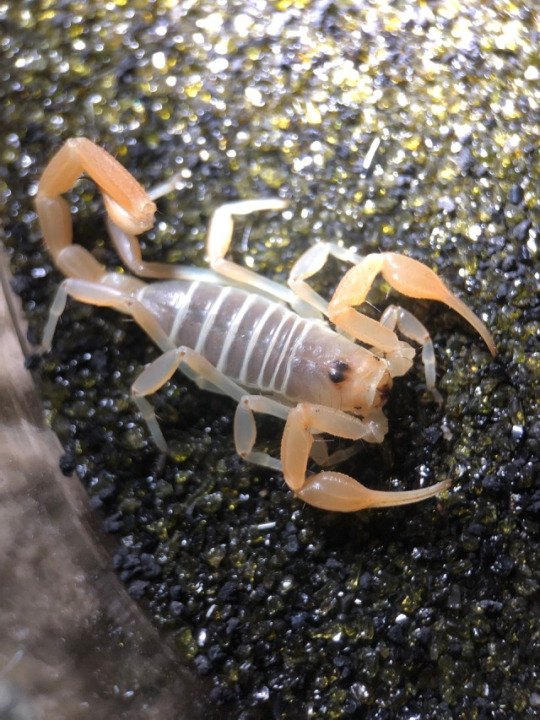

Smeringurus mesaensis, note the lack of tint on the prosoma and the fingers not being significantly darker than the chela.



Smeringurus vachoni, note the distinct darker carinae on the chela and the dark fingers, and the tint on the prosoma going almost completely to the front edge. Middle picture is of the larger tooth present in males. Cutting edge of fingers has multiple teeth or waves (called scalloping).


Smeringurus aridus, note the darker fingers and the slight crescent tint around the median eyes. Cutting edges of the fingers are straight with almost no scalloping.


Paravaejovis confusus, note the uniform brown coloration and the fingers being only slightly longer than the chela.


Paravaejovis puritanus, note the shiny brown appearance, the dusky tint around the leg joints, and the narrow chela.


Paravaejovis waeringi, note the uniform brown appearance and the fingers being distinctly longer than the chela.



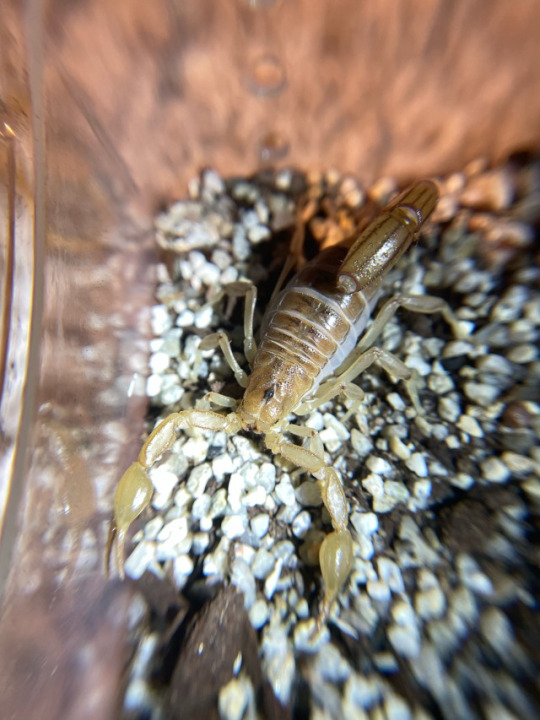
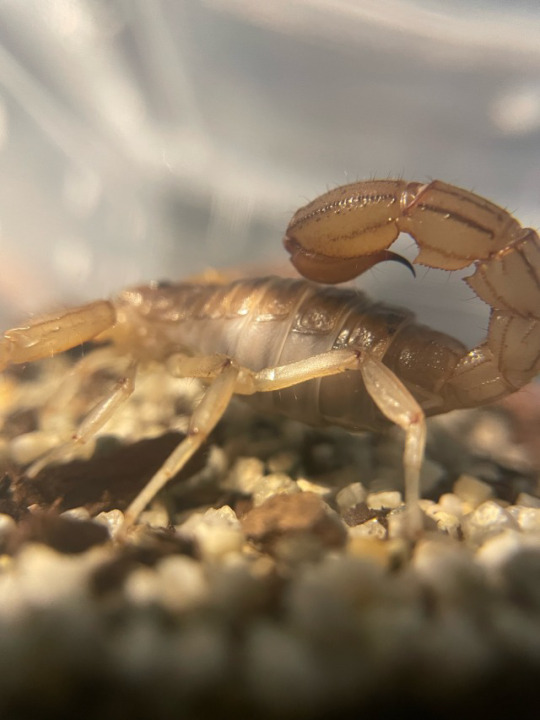
Paravaejovis spinigerus, the patterning ranges from striped to solid brown. Note the distinct lines on the carinae of the tail, and the tail’s bulkier, spikier appearance. Also note the short fingers and bulbous chela.



Vaejovis carolinianus, note the mottling and light granulation in the second picture.
Back to top
#invertebrates#invertiblr#inverts#invert#bugblr#scorpion#scorpion identification#entomology#identification#identification guide#paravaejovis#vaejovis#paruroctonus#serradigitus#smeringurus
2 notes
·
View notes
Text
Modern au where Obi-Wan and Anakin are rival birders going for county/state records each year
#obikin#star wars#an au I'm sure I will be the only target audience for lmao#they end up seeing each other all the time bc they end up following the same birds across state#Obi-Wan gets snarky bc he saw Anakin use a bitd identification software ONCE#anakin throws back that at least his software is up to date unlike obi-wan's field guide#ahsokas just trying to see some cool birds dammit#instead she's freezing her butt off listening to Anakin talk about Obi-Wan's infuriating habit of talking gently to the wildlife
26 notes
·
View notes
Text
I really love birdwatching. I saw a goldcrest right outside my window yesterday and I'm still so excited by it!!! they're the smallest bird in europe!!
#I cannot stress how tiny this bird was#it was so cute#if I'm ever well enough I'd love to go stroll through the countryside with a pair of binoculars and a bird identification guide#I think it would be so fun#talon.txt
3 notes
·
View notes
Text

Isopod differentiation guide is in the works
#it might end up being a giant dichotomous key#we’ll see how it goes#the (iso)podcast#not an identification#isopod differentiation guide#real isopod hours#some of this is also just testing to see if they actually do have differences#I’m not sure if diff Cubaris sp have differences in their pleons/pleotelsons but we’ll find out I suppose
57 notes
·
View notes
Text

Vampire Identification Guide
I haven’t see the new version of Salems Lot yet, but photos are showing up on the internet. Here’s a shot of Alexander Ward as Kurt Barlow.
I’m glad they decided to go in the direction of Reggie Nalder’s 1979 version which was very creepy. Rutger Hauer looked like a blond Dracula and simply wasn’t threatening.



#vampires#salems lot#stephen king#kurt barlow#nosferatu#reggie nalder#rutger hauer#blond Dracula#Alexander Ward#Vampire Identification Guide
31 notes
·
View notes